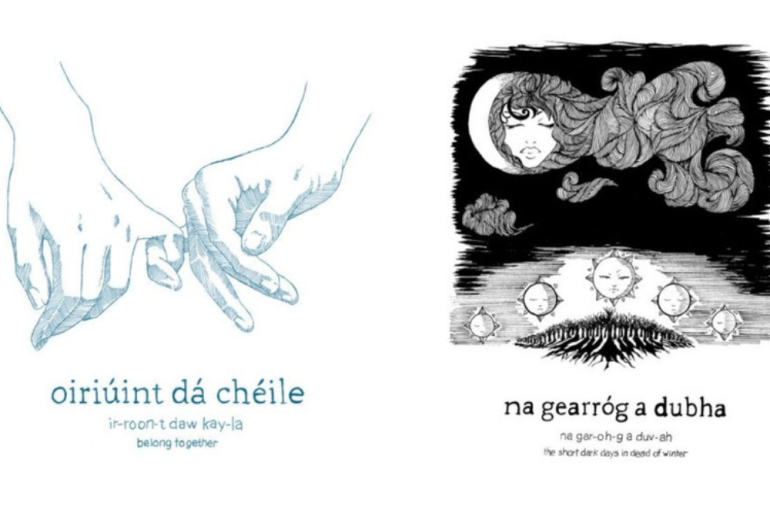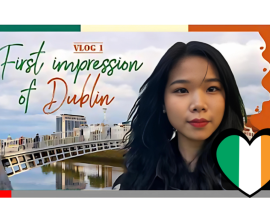Mothú sa bhaile in Éirinn: how language gives a sense of belonging
Introduction
Illustrations by Catherine Geaney
When I told my Dutch family I was learning the Irish language, they were confused: ‘Do you mean you’re learning to speak English with an Irish accent?’ More than once, I’ve had to explain that Ireland has its own language. Irish – or Gaeilge – is one of the oldest and most historically written languages in the world. It has been spoken in Ireland for over 2.500 years. In this blog, I will share how learning this language during my exchange helped me feel at home in Ireland.
Irish: an ancient language in revival
Irish was the dominant language in Ireland until the nineteenth century, when it was replaced with English under British imperialism. Nowadays, Irish is only spoken as the primary language in remote areas which are collectively referred to as the Gaeltacht. However, more and more people across Ireland are integrating the language into their daily life. There is an increasing number of Irish-speaking schools, called gaelscoileanna, and Irish is a mandatory subject in English-speaking schools. There are also Irish radio and television shows. For example, the family I lived with during my exchange watched ‘Grá ar an Trá’ (‘Love on the Beach’), a dating show where participants try to find love while learning Irish.
Cuallacht Cholmcille: the Irish Society
The first time I heard people casually speak Irish was when I met the members of Cuallacht Cholmcille: the Irish Society at Maynooth University. It’s the oldest Irish society in the country. They organise events that allow gaeilgeoirí – Irish speakers – to develop their language skills, such as Irish film screenings, karaoke nights, and pop-up Gaeltachtaí. As an events officer of the Erasmus Student Network (ESN), I hosted an international breakfast in collaboration with Cuallacht Cholmcille to introduce exchange students to the Irish language. The Cuallacht Cholmcille members told us about their experiences as twenty-first-century Irish speakers and shared their hopes for the future of the Irish language.
Irish Classes at Maynooth University
I started learning Irish shortly after I heard that I would go to Ireland for my exchange, by doing daily exercises on Duolingo and listening to Irish music and podcasts. Once I came to Maynooth, I enrolled in weekly two-hour Irish classes on campus at Lárionad na Gaeilge (the Centre for Irish Language). Since I followed my classes at entry level, there were many students from abroad – from Russia to France and from the United States to China. For this blog, I interviewed two of my classmates: Tom and Donna. Tom is from Yorkshire, England. He previously studied linguistics and is now pursuing a Master’s in anthropology. Donna is a born Dubliner, but has been living in Laois for seventeen years. She is a mature student and a mother to five children. “I am what people in other parts of the world used to describe as a typically Irish person,” she says. However, she adds that this stereotype doesn’t accurately represent Irish society anymore. “We are much more diverse now, which is beautiful!”
‘Why would anyone learn Irish?!’
‘Why would anyone learn Irish?!’ That’s what many of my Irish friends said when I told them I enrolled in Irish classes. Some of them called me crazy for investing time in a language they barely spoke after studying it for years. However, others appreciated my effort to learn more about Irish culture this way. When I ask Tom why he is learning Irish, he says: “I find the Irish language particularly fascinating because of its unique features, such as the initial mutations and the broad and slender vowels.” Moreover, with Irish being a distant relative of Romance languages, he finds it interesting to recognise words that are similar to French, Spanish or Italian. “I also love the way the language sounds,” he adds. Donna studied Irish in school, yet she barely spoke it – which is common among Irish people of her generation. She decided to enrol in Irish classes both for her enjoyment and because a basic level of Irish is required to fulfil her dream of becoming a kindergarten teacher.
On a mission to revive Celtic languages
When I started learning Irish, it seemed daunting. Irish is completely different from any language I know. Tom can relate. “The university language courses have a really supportive environment though, which encouraged me to keep at it even when it felt impossible,” he says. “It also feels rewarding when I can understand an Irish road sign. I can notice my progress as I live in Ireland.” He is particularly interested in the revitalisation of underused languages. “Therefore, I feel privileged to have the opportunity to learn an endangered language in its native country.” With his native England’s role in Irish’s decline, he wants to support the use of Irish, even if it’s only a little. Moreover, he hopes learning Irish can be a gateway to learning Celtic languages in the United Kingdom and its dependencies, like Manx (Isle of Man) and Cornish (Cornwall). These languages are spoken far less than Irish and are therefore harder to learn. “I would love to conduct anthropological fieldwork with these communities in the future, to support language revitalisation there,” Tom says.
Passing on Irish to the next generation
An essential step in the revitalisation of the Irish language is to transmit it to the next generation. The way Irish is taught nowadays strongly differs from when Donna was young, she tells me. The teachers in her children’s schools are very passionate, which motivates the students. “The enthusiasm my children have for learning the language is wonderful to see,” she says. They even speak Irish at home sometimes. “As a parent, it’s important for me to incorporate our language and traditional Irish music into our lives in a way that fosters a love of learning and a strong sense of identity,” she continues. “While the history of aspects of our culture, like the origins of the traditional Irish stew and the demise of the Irish language, are filled with poignant sadness, our heritage and culture are what makes us unique. It is our responsibility to pass on our customs, our traditions and our beautiful language to the next generation.”
Conclusion
Following Irish classes during my exchange allowed me to meet new people, challenge my language skills, and connect with Irish culture on a deeper level. Most of all, it gave me a stronger sense of belonging in Ireland. This is something both Tom and Donna can relate to. Donna concludes: “There’s a unique atmosphere when you’re sitting in the local pub with a nice cold pint of Guinness in front of you, traditional music playing, and knowing everyone there. I’ve yet to experience that sense of belonging in any other country I’ve visited.”





